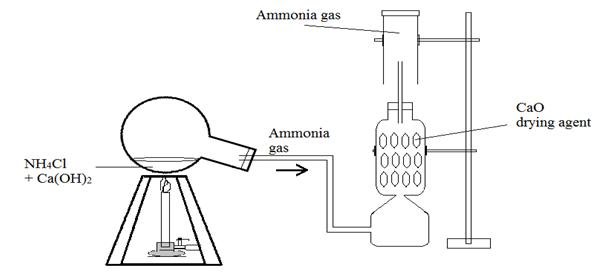TO PREPARE GAS IN LABORATORY AND STUDY ITS PROPERTIES
- APPARATUS REQUIRED
a. Round bottom flask
b. Delivery tube
c. Gas jar
d. Cork
e. Tripod stand
f. Test tube
g. Test tube stand
h. Wire gauge
CHEMICALS REQUIRED
Ammonium chloride (NH4Cl)
Calcium hydroxide or slaked lime (Ca(OH)2)
- THEORY
Ammonium salts when are treated to excess alkali give off ammonia gas. Ammonia gas is prepared in the laboratory by heating the mixture of ammonium chloride (NH4Cl) and calcium hydroxide Ca(OH)2 paste in the ratio 1:3 by weight. The reaction proceeds as,
2NH4Cl + Ca(OH)2 → CaCl2 + 2NH3↑ + 2H2O
Net ionic equation:
NH4+(aq.)+ OH-(aq.) ↔ NH3(g) + H2O(l)
Excess of OH- favours reaction rightwards.
The gas so formed is collected in the gas jar by downward displacement of air, as shown in the figure because ammonia gas is lighter than air.
The gas cannot be collected under water because it is highly soluble in water. If dry ammonia gas is to be prepared, then ammonia gas should be dried by passing through the lime tower. Anhydrous CaCl2 and conc. H2SO4 cannot be used as the drying agent because they react with ammonia.
NH3 + conc. H2SO4→ (NH4)2SO4
Anhydrous CaCl2 + NH3→ CaCl2.8NH3 [Octa amine Calcium Chloride]
- PROCEDURE
The mixture of ammonium chloride (NH4Cl) and calcium chloride (CaCl2) was made in the form of the paste in the ratio 1:3 by weight and taken in an R.B flask. Then, the flask was fitted with the delivery tube and set in slight slanting position supported by the stand with the clamp as shown in the figure. The whole mixture was then heated and ammonia (NH3) gas thus produced was passed through delivery tube, through the lime tower and finally collected in the gas jar by downward displacement of air. Thus, collected NH3¬ gas was used to perform several experiments and the results were observed.
- OBSERVATION TABLE
| S.N | Experiment | Observation | Inference |
|---|---|---|---|
| 1 | Colour of gas was noted | No colour was observed. | Ammonia gas is colourless. |
| 2 | Odour of gas was observed | Pungent odour | Ammonia gas has the pungent smell |
| 3 | A gas jar filled with NH3 gas was inverted over water in the water trough and was shaken up and down | Water level was raised immediately inside the gas jar | The ammonia gas is highly soluble in water. |
| 4 | Few drops of HCl was taken in a test tube and NH3 gas was passed into it | Dense white fumes of NH4Cl was formed | Ammonium Chloride NH4Cl is formed. |
| 5 | The NH3 gas was passed in a test tube containing CuSO4 solution for short time | Bluish white ppt. was obtained | Cupric Hydroxide (Cu(OH)2) was formed. |
| 6 | The NH3 gas was passed in the test tube containing CuSO4 for a long time | The bluish white ppt. first formed changes into deep blue colour after sometime | Tetramine Copper(II) Sulphate complex was formed. |
| 7 | Ammonia gas was passed through FeCl3 solution | Brown ppt. was observed | Ferric hydroxide (Fe(OH)3) is formed. |
| 8 | Ammonia gas was passed through FeSO4 solution | Dirty green ppt. was observed | Ferrous hydroxide, Fe(OH)2 is formed. |
| 9 | Ammonia gas was passed over wet filter paper with Mercurous Nitrate solution | The wet filter paper turned black | Formation of monobasic ammonium mercuric nitrate and finely divided mercury. |
| 10 | Ammonia gas was passed into Nessler’s reagent in a test tube | Reddish brown ppt. was observed | Iodide of Millon’s base (NH2HgOHgI) is formed. |
| 11 | The gas is passed into few drops of phenolphthalein solution in a test tube | Colourless phenolphthalein turned pink | Ammonia gas is basic in nature. |
| 12 | Burning matchstick was introduced into the gas jar filled with NH3 gas | The matchstick fire was extinguished | The ammonia gas is neither combustible nor supporter of combustion. |
| 13 | The moist red and blue litmus paper were introduced into the gas jar filled with NH3 | The red litmus turned blue but there was no change in blue litmus | The ammonia gas is basic in nature. |
- REACTIONS INVOLVED
a. NH3 + H2O → NH4OH(Ammonium Hydroxide) ↔ NH4+ + OH-
b. NH3 + HCl → NH4Cl Ammonium Chloride (dense white fumes)
c. CuSO4 + 2NH4OH →(short time) Cu(OH)2↓(Cupric Hydroxide (bluish white ppt.)+ (NH4)2SO4
d. Cu(OH)2 + 2NH4OH + (NH4)2SO4→(long time) [Cu(NH3)4]SO4[Tetramine Copper(II) Sulphate (deep blue colour)] + H2O
e. FeCl3 + 3NH4OH → Fe(OH)3↓(Ferric Hydroxide (Fe(OH)3), brown ppt.) + 3NH4Cl
f. FeSO4 + 4NH4OH → Fe(OH)2↓(Ferrous Hydroxide (Fe(OH)2), dirty green ppt.) + (NH4)2SO4
g. Hg2(NO3)2 + 2NH3→ [Hg + Hg(NH2)NO3]{Mercuric Amino Nitrate and finely divided Mercury; (black ppt.)} + NH4NO3
h. NH3 + 3K2HgI4 + 3KOH → NH2HgOHgI[ Iodide of Millon’s base (brown ppt.)] +7KI + 2H2O
- RESULT
Hence, in this experiment ammonia gas was prepared in the lab and its several chemical and physical properties was studied and observed.
- CONCLUSION
Thus, ammonia gas can be prepared by the reaction of ammonium salt with alkali and in the lab, it is done with the reaction of NH4Cl and Ca(OH)2. Several physical and chemical properties of NH3 gas can be studied by subjecting it to several chemical reagents and objects.
- PRECAUTIONS
a. The apparatus should be airtight.
b. The R.B. flask should be heated gently.
c. R.B. flask should be kept in slightly inclined position.
d. The apparatus should be clean.

Hi! I am a robot. I just upvoted you! Readers might be interested in similar content by the same author:
https://steemit.com/steemiteducation/@thescienceguy/to-prepare-gas-in-laboratory-and-study-its-properties